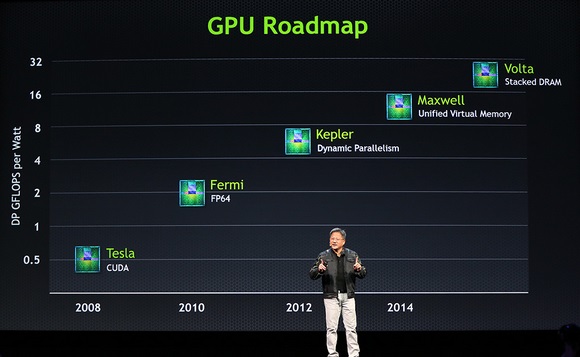NVIDIA CEO Unveils Volta Graphics, Tegra Mobile Roadmap, and GRID VCA Virtualized Rendering Systems
NVIDIA CEO Jen-Hsun Huang kicked off this year’s GPU Technology Conference with his customarily impressive opening keynote. The focus of Jen-Hsun’s presentation was on breakthroughs in computer graphics and advances in GPU computing, but he also unveiled new GPU and Tegra roadmaps and took the wraps off of a brand new small form factor Tegra-based product.
Predictably, Jen-Hsun began the keynote with some glowing words about NVIDIA’s powerful GK110-based GeForce GTX Titan and ran a few demos showing water and face rendering technologies to illustrate just how far computer graphics have come since NVIDIA created their first GPUs. Jen-Hsun showed off their popular Dawn character, but also a “Digital Ira”, which had an ultra-realistic face with equally realistic animations and expressions. The charismatic CEO moved on to talk about the rapid growth in the GPU computing space, and ran through a number of real-world examples that show the benefits of GPU computing. However, things got much more interesting when he began to talk about next-gen products and NVIDIA’s GPU and Tegra roadmaps.

NVIDIA's Jen-Hsun Huang Reveals The Company's Next-Gen Volta GPU Architecture
It was way back in 2011 that NVIDIA first talked about Maxwell, the next-gen CPU architecture coming after the current-gen Kepler. To reiterate, Maxwell, which is slated for a 2014 release, will offer significantly higher performance per watt than Kepler (roughly double) in addition to Unified Virtual Memory support. Today, however, Jen-Hsun revealed some details of the Volta architecture, coming after Maxwell. In addition to the new technologies offered in Maxwell, Volta will again approximately double performance per watt and feature Stacked DRAM. Anytime you have to take a signal off-chip and traverse a PCB and external memory bus before accessing DRAM, the signal degrades and must be slowed down. By using stacked DRAM, that signal can be kept much closer to the chip; in fact it will reside on the same package as the GPU. According to Jen-Hsun, Volta will offer 1TB/s of memory bandwidth to the stacked DRAM over its interface, which is more than 3X the bandwidth of NVIDIA’s current flagship GeForce GTX Titan.
Jen-Hsun also revealed that the image of the stacked DRAM and Volta GPU die were ‘to scale’, for whatever that’s worth. No exact release date was discussed for Volta, but the roadmap slide suggests a 2016 timeframe.

More Tegra Details: Logan, Parker, and Kayla
After talking about Volta, NVIDIA’s CEO moved on to the mobile space with Tegra and its roadmap. Jen-Hsun talked about three upcoming products, two new SoCs codenamed Logan and Parker and what is essentially a small form factor platform based on Tegra, dubbed Kayla.
There weren’t many technical details revealed, but it was explained that Logan will feature a Kepler-based GPU and support CUDA 5 and OpenGL 4.3 “out of the box”. Logan, which according to Jen-Hsun is “the size of a dime” will offer up to 3X the compute performance of current solutions and be demoed later this year, with full production starting early next year.
The follow on to Logan is codenamed Parker. Parker-based Tegra SoCs will feature 64-bit ARM Denver-class CPU cores, with Maxwell-based GPU technology, and be produced using 3D FinFET transistors. Jen-Hsun claimed that “in 5 year’s time” NVIDIA will have improved the performance of Tegra 100 fold. As the slide above reveals, that’s a reference to Tegra 2’s performance versus Parker, which is currently scheduled to arrive sometime in 2015.

Top: Jen-Hsun Holding Kayla, Bottom: Live Kayla Demo
When he was finished discussing the future with Parker, Jen-Hsun then unveiled an existing new product, codenamed Kayla. Kayla is board designed for small form factor systems of some sort that features a Tegra SoC paired with a new, low-power, Kepler-based GPU with support for CUDA 5. Other technical details weren’t given, but Jen-Hsun did show a demo of Kayla running a real-time Ray Tracer and GPU water and smoke simulations simultaneously, using Ubuntu -- all simultaneously. Impressive to be sure.

NVIDIA's GRID VCA Remote GPU-Accelerated Workspace
NVIDIA’s CEO also revealed new details regarding the company’s virtual GPU technology call "GRID." We showed you the GRID server and some of its cloud-gaming capabilities earlier this year in our CES coverage. Just to quickly reiterate, GRID offers virtualized GPU computing and remote graphics capabilities, so a server can handle heavy compute and rendering workloads, while the output is streamed to lower-power clients. NVIDIA’s GRID hypervisor supports 16 virtual machines (1 per GPU) and each GRID VCA (Visual Computing Appliance), which is the name given to each GRID server, will feature one or two 8-Core Xeons, 192GB or 384GB of RAM, and 4 or 8 GRID boards, each with two Kepler-class GPUs, for a total of up to 16 GPUs per 4U system.
Client machines connected to the GRID VCA require a special software to leverage the system’s compute resources. And said software will be available for multiple platforms. Jen-Hsun demo’d a MacBook Pro running a number of applications on GRID, like 3D StudioMax and Solidworks, which aren't even available for Mac OS X natively.
Pricing for GRID VCA systems will range from $24,900 for a base single-CPU (8 threads) / 8 GPU / 192GB configuration (4GB frame buffers for each GPU) to $39,900 for fully-loaded dual-8-core CPU (32 threads) / 16GPU / 384GG setup. Licensing for the GRID client will be $2,400 annually for the base configuration or $4,800 annually for the max configuration.






